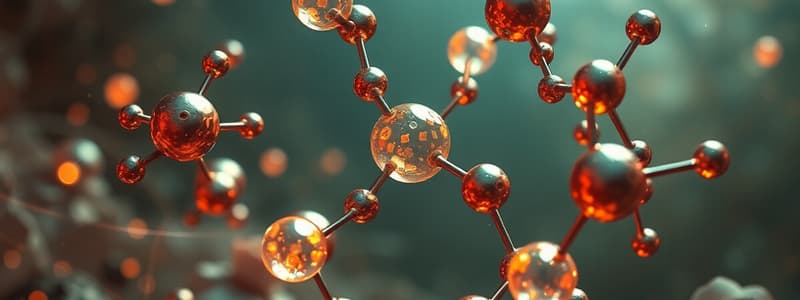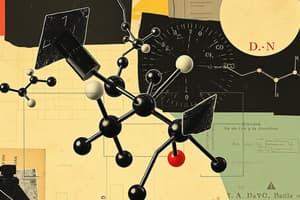Podcast
Questions and Answers
Which of the following molecules is an example of a homonuclear diatomic molecule?
Which of the following molecules is an example of a homonuclear diatomic molecule?
A macromolecule is a very small molecule, often consisting of numerous subunits.
A macromolecule is a very small molecule, often consisting of numerous subunits.
False (B)
What is the difference between a molecule and an ion?
What is the difference between a molecule and an ion?
A molecule is electrically neutral, meaning it has an equal number of protons and electrons. An ion, on the other hand, has a net positive or negative charge due to an imbalance between the number of protons and electrons.
In a ______ molecule, the atoms share electrons equally.
In a ______ molecule, the atoms share electrons equally.
Signup and view all the answers
Match the following molecules with their classifications:
Match the following molecules with their classifications:
Signup and view all the answers
Which of the following is NOT a characteristic of elements?
Which of the following is NOT a characteristic of elements?
Signup and view all the answers
Changing the number of neutrons in an atom creates an ion.
Changing the number of neutrons in an atom creates an ion.
Signup and view all the answers
What are the four types of compounds depending on how the component atoms are held together?
What are the four types of compounds depending on how the component atoms are held together?
Signup and view all the answers
The number of ______ defines an element.
The number of ______ defines an element.
Signup and view all the answers
Match the following terms with their definitions:
Match the following terms with their definitions:
Signup and view all the answers
Study Notes
Atomic Structure
- An atom is the fundamental unit of an element.
- Atoms cannot be broken down by chemical means.
- A typical atom has a nucleus made of positively charged protons and neutral neutrons.
- Negatively charged electrons orbit the nucleus.
- The number of protons defines the element.
- Atoms of the same element can have different numbers of neutrons (isotopes).
- Atomic size is approximately 100 picometers.
- Most atomic volume is empty space.
- Electrons do not always orbit the nucleus in perfect circles.
- Atomic mass is primarily determined by protons and neutrons.
- Electrons contribute negligibly to atomic mass.
- Atoms with equal numbers of protons and electrons are electrically neutral.
- An imbalance in the number of protons and electrons creates an ion.
Molecules
- A molecule consists of more than one atom.
- Molecules have a constant composition.
- The ratio of atoms in a molecule is always the same for that molecule.
- Identical molecules have identical chemical properties.
- Molecules can be broken down into atoms through chemical reactions.
- Examples of Molecules:
- H₂O (water)
- N₂ (nitrogen)
- O₃ (ozone)
- CaO (calcium oxide)
- CO₂ (carbon dioxide)
- C₆H₁₂O₆ (glucose)
- NaCl (table salt)
Types of Molecules
- Diatomic Molecules: Made of two atoms (e.g., O₂).
- Polyatomic Molecules: Made of more than two atoms (e.g., H₂O).
- Macromolecule: Very large molecules consisting of subunits (e.g., proteins and DNA).
Types of Chemical Bonds (Covalent and Ionic)
-
Covalent Molecules: Atoms connected by covalent bonds.
- In pure covalent, atoms have the same electronegativity.
- In polar covalent, atoms have slightly different electronegativities.
- Examples: H₂, O₃, H₂O, HCl
-
Ionic Molecules: Atoms connected by ionic bonds; metals and nonmetals (with exceptions).
- Cations and anions show large differences in electronegativity.
Difference Between Molecules and Ions
- Molecules are electrically neutral, having equal numbers of protons and electrons.
- Ions have unequal numbers of protons and electrons, resulting in a positive or negative charge.
Elements
- Elements are substances composed of only one type of atom.
- Elements cannot be broken down into simpler substances through chemical reactions.
- Elements are fundamentally defined by the number of protons.
- Elements are represented by unique symbols, typically on the periodic table (e.g., C for carbon, O for oxygen).
- There are currently 118 known elements.
Compounds
- Compounds are formed when two or more different elements combine in a fixed ratio.
- Compounds can be broken down into their constituent elements through chemical reactions.
- Compounds have different properties than the elements that make them up.
- Examples: CO (carbon monoxide), CO₂ (carbon dioxide), H₂O (water)
- Types of Compounds: covalent, ionic, and others
Chemical Reactions
- A chemical reaction involves breaking bonds in reactants and forming bonds in products to create new substances.
- Reactants are the initial substances, and products are the resulting substances.
- Chemical reactions are common in everyday life—food digestion, respiration, burning fuel.
- Chemical reactions are categorized into several types (e.g., combustion, decomposition, neutralization, redox, precipitation, synthesis).
Chemical Equations
- Chemical equations use symbolic representations to describe chemical reactions.
- Elements are represented by their symbols (e.g., H₂ for hydrogen).
- Compounds are represented by their chemical formulas (e.g., H₂O for water).
- Chemical equations show the reactants and products, with the direction of the reaction using symbols (→, ⇌, or other).
- Coefficients in front of the formulas show the relative number of molecules or atoms involved.
Types of Chemical Reactions
- Combustion: Reaction with an oxidizer (typically oxygen).
- Decomposition: Breakdown of a compound into simpler substances.
- Neutralization: Reaction between an acid and a base.
- Redox: Transfer of electrons between substances.
- Precipitation (Double Displacement): Exchange of ions between two compounds.
- Synthesis: Combining simple compounds to form a complex compound.
Studying That Suits You
Use AI to generate personalized quizzes and flashcards to suit your learning preferences.
Related Documents
Description
Test your knowledge on molecular structures, including diatomic and homonuclear molecules. Explore the differences between ions and molecules, and understand the characteristics that define elements. This quiz will challenge your understanding of chemical compounds and electron sharing.




